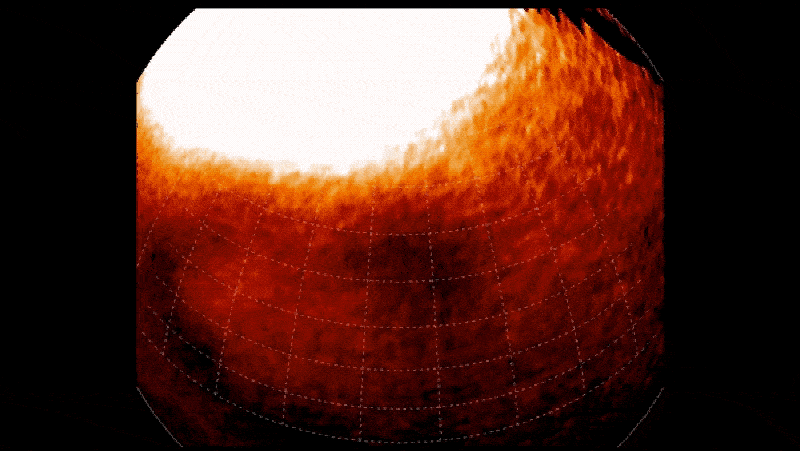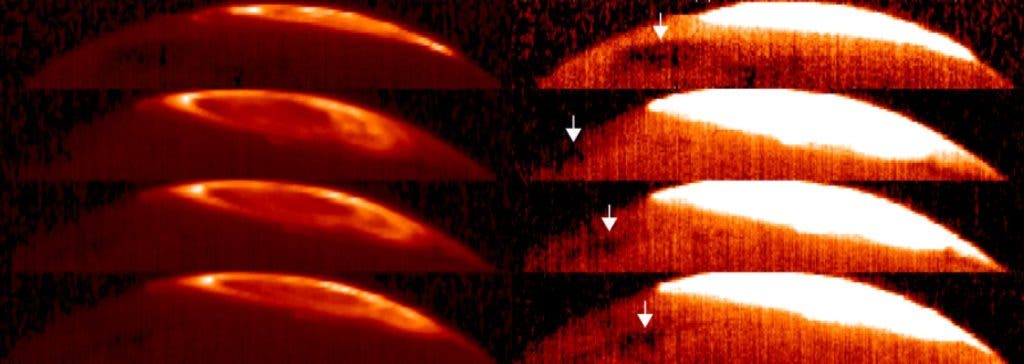Jupiter’s more well-known Red Spot has a sister, a cold spot which may have existed for thousands of years — but this is the first time we’ve seen it.

The Great Cold Spot was first discovered on Jupiter using observations taken of Jupiter’s auroral region by the CRIRES instrument on ESO’s Very Large Telescope. This is a computerized image of the Great Cold Spot as it would appear directly above Jupiter at a distance of 22,000 miles (35,000 km) above the planet. (Image: NASA/IRTF Telescope/University of Leicester).
We’re all familiar with Jupiter’s great Red Spot, the stormy, hellish zone of high pressure which may have existed for hundreds of years, but the Cold Spot may have existed even longer than that. It manifests itself as a localized dark spot, up to 24,000 km in longitude and 12,000 km in latitude, in the gas giant’s thin high-altitude thermosphere. The spot is around 200 degrees Celsius cooler than the surrounding atmosphere, whose temperature ranges from between 700Kelvin (426ºC/799ºF) and 1000K (726ºC/1339ºF).
Astronomers confirmed the existence of this spot using the Very Large Telescope array, which consists of four individual telescopes, each with a primary mirror 8.2 m across. Although it was only recently ‘officially’ discovered, researchers from the University of Leicester found it in previous recordings, confirming it in data up to 15 years old. Dr. Tom Stallard, Associate Professor in Planetary Astronomy and lead author of the study, marked the significance of this Cold Spot.
“This is the first time any weather feature in Jupiter’s upper atmosphere has been observed away from the planet’s bright aurorae.
“The Great Cold Spot is much more volatile than the slowly changing Great Red Spot, changing dramatically in shape and size over only a few days and weeks, but it has re-appeared for as long as we have data to search for it, for over 15 years. That suggests that it continually reforms itself, and as a result, it might be as old as the aurorae that form it — perhaps many thousands of years old.”

The Great Cold Spot cannot be seen clearly until these images are saturated so that the entire aurora becomes white, as shown on the right. Here, the planet glows as a result of the temperature of the upper atmosphere, and the distinct regions of cooling that reveal the Great Cold Spot can be seen. Based on data from VLT/ESO.
Credit: Image courtesy of University of Leicester.
It was impressive to see that although it changes shape every few days or weeks, as a planetary feature, it remains incredibly stable. This makes it unlike the weather patterns seen on Earth, and more like Jupiter’s weather systems — especially, the Great Red Spot.
It is believed that the cold spot is caused by the magnetic field asymmetry of Jupiter’s north pole — the massive aurorae drive energy in the form of heat, creating an unstable feature (which is why it constantly changes shape) which is constantly regenerating, time and time again. Unlike Earth’s aurorae, Jupiter’s aurorae generate a lot of heat,
“We speculate that this is a weather feature caused by the neutral atmosphere moving differently in the auroral region and at lower latitudes,” explained Stallard. “In both Jupiter and Earth’s lower atmosphere, when two regions of the atmosphere flow past each other, it can produce a vortex, which then causes localized changes in conditions. This may be creating a localized cool region in the upper atmosphere.”
The finding shows that Jupiter’s atmosphere is much more complex than we have anticipated. Now, astronomers want to study the cold spot in more detail, as well as find other similar features in Jupiter’s atmosphere.
Journal Reference: Tom S. Stallard, Henrik Melin, Steve Miller, Luke Moore, James O’Donoghue, John E. P. Connerney, Takehiko Satoh, Robert A. West, Jeffrey P. Thayer, Vicki W. Hsu, Rosie E. Johnson. The Great Cold Spot in Jupiter’s upper atmosphere. Geophysical Research Letters, 2017; DOI: 10.1002/2016GL071956









